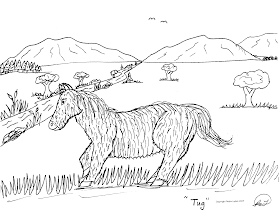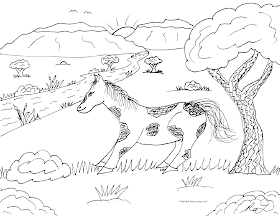CLICK THE BUTTON: "Free Printable Downloads" LOCATED AT THE TOP OF THE BLOG...
to be able to print FREE coloring pages!
Continue to scroll down to preview the coloring pages
to learn about the animals etc.
Today is the one month anniversary of my blog. Since that date I have undergone trachea surgery and helped take care of my wife who had complications from the flu...she got pneumonia. She has finished a run on antibiotics and is doing much better. As for my health, my heart was just put through a test and my medical provider is thinking I may need a heart transplant one day, but for now I am OK. He is just concerned that things will probably get worse. I started this blog as a way to leave my drawings for people to enjoy and color. Today we took around 30 pictures to an assisted living facility for the residents to color. I am truly disabled so getting the copies of my drawings made was exhausting and led to some painful complications in my trachea that I won't describe. But, we do our best to serve our fellowman in whatever small way we can. I think that is a great truth in life. We should do the best we can to share our talents/skills, however meager they may seem, to make a difference in the world by making a difference in the lives of others. I want to quickly give you a few examples where we have served over the years. We will never be rich and famous, but hey, you can't take it with you anyway and we like to serve. I play baritone ukulele. I am not that good, but I wrote song parodies to teach science history and science concepts. I also wrote song parodies about children's books when I was an elementary teacher. When my first wife and I broke up and I had two little girls to raise, I took them to the local nursing home to sing for the Alzheimer's patients on Sundays. It at first was my distraction from the pain I felt at having failed in my marriage. They, the residents, were not critical and it was amazing to see how lucid they would become to hearing familiar songs. (They also liked how cute my little girls were!) I have played harmonica for residents in assisted living centers. I admit that I am not the best musician, but I try. My wife has taught Geology classes to people in assisted living facilities. She has put on magic shows for Jr. High age kids. She even volunteered at my Jr. High after she had retired form teaching science and was a great asset to me, the Science Department, and the entire school. We all have talents in some way. Instead of bemoaning that you are not Bruce Springsteen or Gloria Estefan or Taylor Swift or Pablo Picasso or Albert Einstein or J. K. Rowling, just share the talents you have...whatever talents or skills or knowlege you have...no matter how meager you may think your abilities are. You
can make a difference. If you look at my art on this blog you can be critical of it. You can possibly draw better, but I am sharing
my talents and doing
my best to get better as I go along. Besides, such as they are, kids LOVE to color my drawings! (Some adults love to color the drawings too.) Please remember, never be critical of other people's efforts to serve others... just go thou and do likewise.
I also like to share my knowledge about dinosaurs along with my drawings. So here we go on
Ceratopsians:
Ceratopsian Dinosaurs were the horned dinosaurs. They had a shield or frill with a hooked beak of a mouth and many had horns. There are several kinds with some of the earliest being Protoceratops and Montanoceratops. Those two dinosaurs were the size of a sheep. The biggest Ceratopsian was the size of a semi truck,. The biggest was the well known Triceratops. There were many different sizes of Ceratopsian dinosaur in between Protoceratops and Triceratops...such as Styracosaururs or the newly discovered Machairoceratops.
Paleontologists have discovered places where hundreds of Ceratopsian dinosaurs apparently drown in what appears to have been a herd crossing a swollen river. Because of this we can infer that Ceratopsian dinosaurs were herding animals. A modern example is the American Bison (Buffalo) and Caribou. Because we can observe Bison defending their young we can infer that large herds of Ceratopsian dinosaurs may have put their young in the center of the herd to help them be safer from predators like T. rex or raptor dinosaurs.
Protoceratops
This is thought to be possibly the first Ceratopsian Dinosaur
This animal lived in what is now the Mongolian Desert.
It was a desert in the Late /Cretaceous Period too.
Notice that this drawing is more realistic with the Protoceratops'
feet having toes instead of hooves.
Zuniceratops
This was one of the smallest Ceratopsian dinosaurs at only 11 ft. (3.5 m) and
weighing only about 330 lbs. (150 kg.). Notice that there is no nose horn.
This is NOT a Triceratops. It was WAY smaller than a Triceratops.
This drawing is more for younger children. To be more realistic I would have
made it's feet have claws not hooves. The early or first Ceratopsians had toes, not hooves.
I also would have drawn the body, legs etc. thinner....
because this dino just didn't weigh much!
Of course not many people now days weigh this much.
Maybe an NFL lineman or the props in Rugby.
This dinosaur was about 6 (1.8 m) feet long and weighed about 900 lbs. (400 kg.)
Can you guess where it was found? (Or, it was found in what state?) It was once thought that it had a nose horn, then they figured out that it was a misplaced cheek horn.
This dinosaur was 19 feet long (6 m) and weighed 6,000 lbs. (2722 kg.)
It is thought that its horn could point either towards the front
or curve towards the back like in
this drawing.
Styracosaurus
Styracosaurus was a large Ceratopsian that was unique because it had full
size horns on its frill to apparently protect its neck from predatory dinosaurs.
Styracosaurus was 18 feet (5.5 m) long.
The nose horn alone was 20 inches (57 cm) long.
Machairoceratops
This dinosaur was 26 feet (8 meters) long.
It had a very interesting horn placement.
Its frill horns pointed forward like the eyebrow horns.
This is one of the newest discoveries in the
Grand Staircase Escalante National Monument in Southern Utah.
Triceratops horridus
Triceratops was the biggest Ceratopsian. They had one of the biggest heads of any land animal. They were about 30 ft (9 m) long and weighed in at up to 26,000 lbs (11.8 metric tons).
They were also close to 10 feet tall (3 meters).
Triceratops vs T.rex
This is an educational drawing with the animals,
plants and even the volcano identified.
It is meant for younger children to color.
Since some modern animals have eye spots to make themselves
look larger, it is inferred that perhaps some Ceratopsian
dinosaurs had eye spots on their frill.




















































